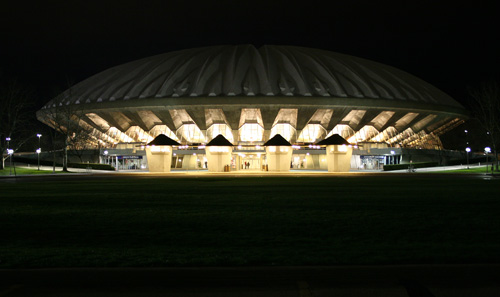Assembly Hall costs remain indefinite

April 16, 2008
$90 million.
This is what renovating Assembly Hall would have cost based on the 2002 plans, said Mike DeLorenzo, associate vice chancellor and director of auxiliary affairs. However, with the extensive work that must be done, the amount is not definite, he said.
“We are still in the process of getting the architects and engineers on board,” DeLorenzo said.
DeLorenzo said that had the Office of Student Affairs not worked with the Division of Intercollegiate Athletics on this project, a majority of this hypothetical amount would have fallen on the students, forcing the student fees to cover about 45 percent of the renovation.
“Without the DIA’s fundraising ability, the fee would have risen by a ridiculous amount,” DeLorenzo said. “It allows us to pay for construction while keeping the weight off the backs of the students.”
Get The Daily Illini in your inbox!
Student Affairs and the DIA may be working to keep the building expenses to a minimum, but their renovation efforts have one main goal. The building must comply with the Americans with Disabilities Act of 1990.
The act is a civil rights law that prevents discrimination against people with disabilities under certain circumstances, including building access.
Kevin Ullestad, director of Assembly Hall, said the building was not required to follow the act because it was built in 1963. But should Assembly Hall be renovated now, the refurbished building must be in compliance with the Americans with Disabilities Act. The renovations would have to include factors such as access to the floor for disabled people as well as larger ratios of available seating.
“There are many (Americans with Disabilities Act) issues, and right now we don’t have wheelchair access to the floor,” Ullestad said.
The act would also apply to bathrooms, concessions and the seats in the highest part of Assembly Hall, section C. Ullestad said elevators or escalators would help make the building more accessible, but whether those methods will be used is still unclear.
“The building is not accessible the way we want it to be,” Ullestad said.
Ullestad also said he believes installing an air conditioning system may be a difficult task. The University purchased a chiller line that runs under First Street and may be used to supply Assembly Hall with cool air. However, the current system cannot handle the level of output that the line would generate.
Ullestad said the hall’s air system would have to be updated or completely replaced in order for the building to include this resource. How this would affect the structure or cost of renovation is also unknown.
“We can’t just turn it on,” Ullestad said.
DeLorenzo said that there is a second option.
Instead of using the chiller line, a separate external unit could be purchased that would ventilate and cool the entire area in combination with the current system.
Student Affairs and the DIA are working with architects and engineers to determine which system would be more effective while being less expensive. The final plan will likely be determined by the fall semester.






